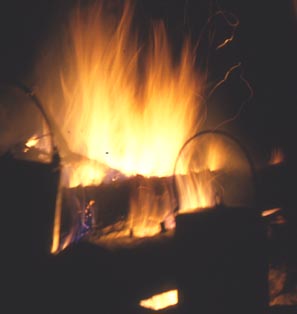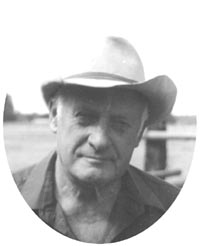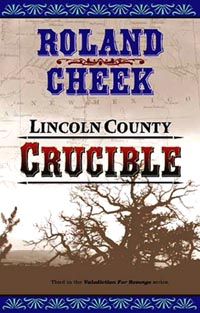a weblog sharing info on outdoor skills and campfire musing by a guy who spends a bunch of time in pursuit of both
CULTURE
WHERE -
TALES ARE TOLD OF
Welcome to Roland Cheek's Weblog
Roland is a gifted writer with a knack for clarifying reality. Looking forward to more of his wisdom
- Carl Hanner e-mail
I cut my teeth as a writer through sharing outdoors knowledge gleaned by experience, first as a hunter, then as an observer of wonders beyond that afforded by the tunnel vision of a rifle scope. As competence advanced, it seems the value of those things I shared advanced apace. Soon observation begat a desire for understanding. Thus far, my understanding only expands to recognize I'll never know more than a mere fraction of all provided by God and nature. Some of my understanding, I now feel, cannot come through observation alone, but by also staring into a multitude of campfires . . . and thinking.
To access Roland's weblog and column archives
Tip o' the Day
I spotted the thunderhead when it first peeked its puny topknot above the western ridges. Nothing to be concerned about was my first thought. But after repeated glances over my shoulder as that tiny cloud swelled to block the sun and fill the sky, I commenced second-guessing my first impression.
Marc had the cloud in his sights, too. He'd twisted in the saddle to check the loads on his packhorse and saw the darkening mass as it was building. "We going to make it to camp first? he shouted over the head of his friend.
I held my hands out, palms up. A few minutes before and I would've said yes, but those thunderheads seemed to be taking on a life of their own, heading somewhere in a hurry. A few minutes later and the sun blinkered out like somebody'd thrown a celestial light switch.
The two boys and I were on our way into the wilderness to set up a hunting camp. It was late August, just before school started. We still had three miles to go to our destination. Then we had to unpack and unsaddle our horses and set up a tent before we could presume ourselves sheltered from the elements.
I glanced again at the sky, then glanced at the boy riding between my son and me. Marc was someting else, already a mountain veteran at thirteen. But his school chum, though a brilliant student, always seemed slow on the uptake to me. "One boy, all boy," I muttered. "Two boys, half a boy."
Above our heads the billowing, churning black mass spread from horizon to horizon. No way were we going to make it! Marc's friend looked around, startled. "What happened to the sun? he said. Then he peered at the sky for the first time. "Where'd them clouds come from?"
Just then the first hailstone fell. It was as large as a golf ball, clipping through scattered lodgepole pine branches twenty feet to the right. Another fell ahead of Marc, and another bounced off a pack carried by my second packhorse. "Head for the wolftrees!" I shouted to the boys.
Our trail snaked along a gentle slope of scattered pines. Up the hill, a half-dozen large, shrubby firs grew. Marc needed no encouragement, reining his little gelding for the shelter. The stones fell thicker and thicker. I reached the first shelter tree and leaped from the saddle, lashing my pony's halter rope to a stout limb. Two packhorses began bucking as the hailstones pounded them. "Ow!" came a cry from the trail.
I wheeled. Marc's friend still sat his horse where we'd left him. A hailstone struck him squarely atop the head. "Ow!" he cried again.
"Dammit, boy," I shouted. "Get off that horse and under a tree.
"Ow!" he cried, as he ran for my tree. "Ow!"
In only a few more minutes, the hail ended as suddenly as it began, turning to a drenching, mind-numbing rain that was more "Oh!" than "Ow!"
First book in Roland's popular Valediction For Revenge Western series
OF MOUNTAIN MAN AND MINING MEN
We hiked to scenic Rock Lake in the Cabinet Mountains Wilderness. The trail--actually an overgrown mining road--climbed along the East Fork of Rock Creek, passing through a series of tumbled-down, corrugated-iron shanties and old prospect holes. The buildings and diggings provided mute testimony to the fact that this region once crawled with secretive men whose single object in life was to keep their nearest neighbors oblivious to discovery of an off-beat streak of color snaking through a chunk of quartz.
We passed te dark hole of a horizontal mine shaft that seemed to leave an entire mountain exclaiming "OH!" in surprise. Nearby were rusted remains of an old stamp mill.
Mining men, I'm told, are yet interested in this hillside, this drainage, this mountain range. It was gold before, and it's gold now. And silver. And perhaps copper. Before it was with pick and shovel. Today it's to bore great holes to accommodate giant motorized ore trucks carrying millions of tons of precious metal-bearing ore from mountain bowel to canyon mouth.
Rock Creek itself is a beautiful, cold, clear, fast running stream that sufficiently healed itself from the effects of yesteryear's mining for westslope cutthroat trout and brawny bull trout to call its waters home. There's a broad, basin-bottom beaver marsh spreading along the Rock Creek's upper reaches. By tell-tale tracks left in its mud, the marsh is home to moose and whitetail deer. Mallards float its ponds. Harlequins, I'm told, fly the cataract mists where Rock Creek tumbles down-canyon, below the basin.
I paused where man had gone and marveled. Just to penetrate this boulder-strewn mountain canyon was not so much a tribute to engineering acumen as much as testament to stubborn will. Each square nail, each sheet of rusted corrugated iron roofing, each bridge timber and fallen-in outhouse, and pile of mine tailings represented a dream, a prayer, loads of sweat, and buckets of tears. Especially the tears. Especially the tears in midwinter while threatened from above by snowloads given to avalanches, too cold to work, and too given to memories of gentler places in gentler times.
The day I climbed to Rock Lake is the first time I realized that propectors of yore had to be the equals of my mountain man heroes when it came to backwoods savvy and perservering survival. True, trappers from David Thompson's brigades probably penetrated to these beaver ponds shortly after and Lewis and Clark passed through to the south. But the beaver men were only here for a brief time and left; then only following the valley bottoms while shunning the steep dangerous mountainsides.
Miners, on the other hand, stayed until they starved, hope died, or they struck it rich. They clambered up the highest peaks, dug holes in the most tenuous mountainsides--the mine shaft and remains of the old stamp mill were actually athwart an avalanche path!
Mountain men were, by their very nature, given to gregariousness during their summer rendezvous, given to brawling and fornication and wild, wild camaraderi. Miners, conversely, were solicitors of solitude, secretive, suspicious. Even on the rare occasions when they were driven to town by necessity--by illness, injury, or a need for supplies--they drank alone, occupying corners so dark even sheepherders shunned them.
Those miners are gone from anything but history. Today's variety occupy boardrooms and employ engineers, geologists, and chemists.
I found it difficult to reconcile the differences between the two in my mind while on my way to Rock Lake.
Roland Cheek wrote a syndicated outdoors column (Wild Trails and Tall Tales) for 21 years. The column was carried in 17 daily and weekly newspapers in two states. In addition, he scripted and broadcast a daily radio show (Trails to Outdoor Adventure) that aired on 75 stations from the Atlantic seaboard to the Pacific Ocean. He's also written upwards of 200 magazine articles and 12 fiction and nonfiction books. For more on Roland, visit:
www.rolandcheek.com
Recent Weblogs
Tuesday, August 12, 2008
What makes Roland's Westerns different from most? The expertise he brings to his writing. Has something to do, perhaps, with the 35,000 horseback miles he put in while guiding other folks to adventure amid some of the most rugged mountains in all the Northern Rockies
see the books, read reviews, read their first chapters
There's a bunch of specific info about Roland's books, columns, archives and radio programs. By clicking on the button to the left, one can see Roland's synopsis of each book, read reviews, and even access the first chapter of each of his titles. With Roland's books, there's no reason to buy a "pig in a poke."
for detailed info about Roland's radio show and each of his books
Read Reviews
Read their first chapters
For interested educators, this weblog is especially applicable for use in history, economic, and government classes, as well as for journalism students.
Roland, of course, visits schools. For more information on his program alternatives, go to:
NEXT WEEK:
HOW DOES GOD DO IT?
www.campfireculture.com
source links for additional info
to send this weblog to a friend
to tell Roland what you think of his Campfire Culture weblog
to visit Roland's newspaper columns and weblog archives
Books two and three are set amid New Mexico's violent, bloody Lincoln County War
Book four in the Valediction For Revenge series, Gunnar's Mine, is set in Colorado's mining country, as is the sixth and final book in the series, The Silver Yoke
Fifth book in the Valediction For Revenge series
Sixth and final book in the Valediction For Revenge historical Western fiction








